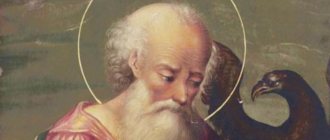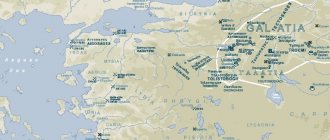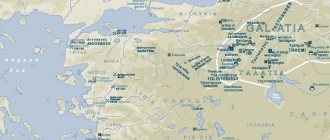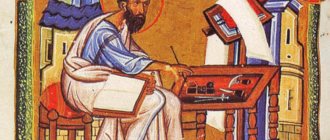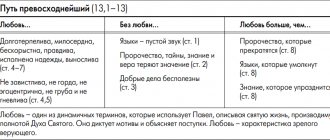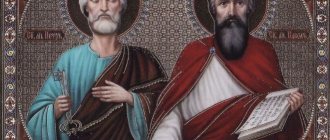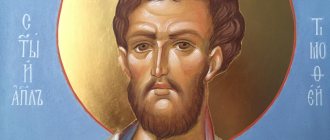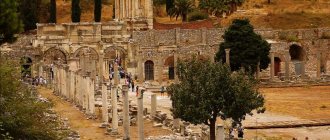Jesus Christ recruited disciples who helped Him carry the light of true faith. His disciples were called apostles - from the Greek “messenger”. There were 12 people in total.
Saul
this is the name given to the Apostle Paul at birth
However, there was another one who was not included in the number of canonical apostles, but one who did almost more for the Christian faith than all the others. His name was Saul of Tarsus.
The ancient city of Tarsus - the birthplace of the Apostle Paul
Before his conversion, Paul was a persecutor of Christians
Information from the life of the Apostle Paul is provided to us by the Acts of the Holy Apostles, as well as his epistles.
Paul was a Jew by origin, and from a Pharisee family. Like all Pharisees, he rejected Christ and his teaching and participated in the persecution of Christians.
Damascus
capital of Syria, here Paul was blinded
The Lord knew that Paul would be one of the most zealous admirers and disseminators of the faith of Christ. As a show of power, He blinded Paul on the road to Damascus.
In Damascus, the godly man Ananias healed Paul. The former persecutor of Christians, having seen the power of the Lord, became their main supporter.
Venerable Apostle Paul, icon
Paul went out preaching widely to the Gentiles. Christian communities became open to all peoples. He went to where:
“...there is neither Greek nor Jew, circumcision nor uncircumcision, barbarian, Scythian, slave, free, but Christ is all and in all.”
(Colossians 3:11)
Where did the apostle preach?
With good reason and without false modesty, he called himself the one who worked more than the other Apostles. After all, it was through the works of this man that thousands of people were converted to Christ, and the Christian Church began to become Universal. The path of his earthly life was long, but the miles traveled along the roads of the vast Roman Empire were also considerable.
Iconography: Paul, the Apostle Dates: XVI century. First third of the 16th century. Origin: the icon as part of the Deesis rite entered the museum in 1941 from the Church of the Intercession in the village of Gumenets, Rostov region. The icons were moved there in 1824 from the Church of Demetrius of Solunsky in the village of Ponikarovo, Rostov district. Material: wood, pavoloka, gesso, tempera Icon dimensions: height 95 cm, width 63 cm Half-length image of the Apostle Paul in a three-quarter turn. Inv. No. I-546. © State Rostov-Yaroslavl Architectural and Art Museum-Reserve. Literature: Vakhrina V.I. Icons of Rostov the Great. M., 2006. No. 22. P. 100-102.
“Brethren, I am a Pharisee, the son of a Pharisee. For the hope of the resurrection of the dead, I am now being judged!” - this is what the Apostle Paul said at the Sanhedrin trial in the “case” of preaching a new and unknown teaching to them. These words are his life.
Useful materials
Persecutor of the Church
Born into an educated Jewish family, having learned the Law of Moses from the great lawyer Gamaliel, Saul - for that is his name in Judaism - was an ideological and convinced persecutor of the “Galilean faith,” as it was contemptuously called. Not only was it preached by simple, uneducated fishermen. Moreover, what they said, according to the Law and common sense of the Jews, was impudent and very blasphemous. God became Man, lived in the world, died a most shameful death on the Cross, and then... rose again!
According to the Law, any of these, in the opinion of the Jews, unheard-of insults to God deserved death. Saul persecuted Christians wherever and whenever he could. He was honest, zealous in his own way, but he loved God passionately. And faith was not disgraced.
"From Saul to Paul"
Christ Himself, having appeared to Saul on the way to Damascus (he was going there to find and arrest the “Galileans” there too), turned him to Himself. “Saul, Saul! Why are you persecuting Me? Paul recalled these words of love and reproach, spoken by Him from the ineffable light that shone upon Saul and all those who were with him, decades later.
Saul's repentance was great. Even his very name in Christianity - Paul - is translated from Latin as “small”, even “smallest”.
This is how he saw himself - “the least of the Apostles”, “as if some kind of monster... because he persecuted the Church of God...”.
Having humbled himself, putting his great learning into nothing, Paul was able to become the chosen vessel, as Christ called him, knowing what fruits the former Saul would bring by changing his life. Surprisingly, the most educated apostle in the Law, an orthodox Jew, spoke of the fact that for God “there is neither Greek nor Jew.”
And he not only said this, but also did it: preaching Christianity to the pagan world, he went around most of the Roman Empire. Paul did something that a devout Jew would not have dared to do:
“He became like a Gentile to the Gentiles...he became all things to all, that he might save at least some.”
Thus, burning with Divine jealousy and not relying on himself, Paul completed his long journey. The path of his earthly life was long, but the miles traveled along the roads of the vast Roman Empire were also considerable.
After converting to Christianity, Paul went to preach
After his baptism, Paul returned to Jerusalem. In the temple, he turned to the Lord with a question about atonement for the guilt before Him and His followers. The Lord's decision was clear:
And He said to me: “Go; I will send you far away to the Gentiles."
(Acts 22:21)
Thus began the missionary travels of the Apostle Paul.
Map of the Apostle Paul's Journeys
Bible Craft – Go Around the World
What you need:
- Template page (on cardstock for best results),
- Pencils
- Scissors
- Paper staple
What to do:
- Color the template pages.
- Cut out the world and the boat.
- Secure together using a paper staple
Paul went to preach according to the will of God
On his first journey, Paul limited himself to a small area in the south of Anatolia.
The journey began in Antioch, the capital of Syria.
1. In Antioch, in the church there, there were certain prophets and teachers: Barnabas, and Simeon, who is called Niger, and Lucius of Cyrene, and Manael, a fellow pupil of Herod the tetrarch, and Saul.
2. While they were serving the Lord and fasting, the Holy Spirit said, “Set apart for Me Barnabas and Saul for the work to which I have called them.”
(Acts 13:1-2)
Paul's companion on his first missionary journey was Barnabas, an apostle from 70
Paul and Barnabas went to Cyprus. In Cyprus they exposed the false prophet Barijesus (Elymas) and, turning the power of God on him, blinded him.
Then the proconsul, seeing what had happened, believed, marveling at the teaching of the Lord.
(Acts 13:12)
Having converted the proconsul, Paul and Barnabas sailed to the mainland and began preaching in the city of Perga. The sermons were a great success:
The following Saturday, almost the entire city gathered to listen to the word of God.
(Acts 13:44)
The vast majority of pagans converted to Christianity. Paul's successes frightened the local Jewish community. The Jews obtained from the authorities the expulsion of the apostles. Paul and Barnabas went north to Iconium.
In Iconium, the situation repeated itself: success in spreading the new teaching and the resistance of the Jewish community, which turned the local authorities against Christians. The apostles had to leave for Lystra.
In Lystra, the miracles that the apostles performed led to an unexpected effect. Paul and Barnabas were declared... Hermes and Zeus.
In Lystra, Paul almost won the laurels of the ancient Greek god Hermes, the patron saint of merchants, travelers and magicians
The priests gathered to bring sacrifices to the descended “gods”. Pavel barely managed to dissuade them.
Then a familiar situation repeated itself: the Jews set the local population against the apostles. They threw stones at Pavel and, beaten, dragged him outside the city.
The apostles set off on the return journey along the same route. The sown seeds had already borne fruit: Paul no longer preached, but ordained priests and left behind strong Christian communities.
The apostles returned to Antioch:
Having arrived there and gathered the church, they told everything that God had done with them and how He had opened the door of faith to the pagans.
(Acts 14:27)
The first missionary journey of the Apostle Paul was over.
Paul went on his second journey after the Apostolic Council
On his second journey, Paul reached Greece.
The success of converting pagans to Christianity raised the question of observing Jewish rituals among Christians.
The converted Pharisees believed that since Christianity came from Judaism, Christians should follow Jewish rules and perform Jewish rituals.
Paul took exactly the opposite position. Peter supported him, and the rest of the apostles listened to Peter.
There was a final break between Judaism and Christianity.
At the Apostolic Council in 51, Christianity turned from a Jewish sect into a new religion
Having settled the dogmatic issues, Paul, taking the apostle Silas with him, set off on a second missionary journey.
Silas, apostle from 70, companion of Paul on his second journey
Paul and Silas, having passed through Syria and Cilicia, went to preach in the central and northwestern regions of Anatolia: Phrygia, Mysia and Troas. The trip went well:
And the churches were established by faith and increased in number daily.
(Acts 16:5)
In Troas, Paul had a vision:
...a certain man, a Macedonian, appeared, asking him and saying: come to Macedonia and help us.
(Acts 16:9)
The apostles went to Macedonia, to the city of Philippi. They converted a woman who was famous as a prophetess to Christianity. This angered the local population. A familiar situation repeated itself: the apostles were beaten and taken into custody.
There was confusion: Paul and Silas were Roman citizens. They couldn’t just be taken and thrown into prison. Having learned about this, the city authorities were horrified and quickly escorted the apostles out of the city.
Caracalla granted Roman citizenship to all free inhabitants of the empire only in 212. The high status and broad rights of a Roman citizen placed him above local authorities, which Paul took advantage of
From Philippi the apostles went to Thessalonica, where they were able to convert many of the local population to Christianity. Local Jews tried to stir up discontent and set the authorities against the apostles, but the Greek convert Jason came to their defense. The apostles left the city in peace and went to Athens.
Athens
the capital of Greece, where Paul converted many Greeks to Christianity
In Athens, Paul clashed in a dispute with the Epicureans and Stoics right at the Greek meeting - the Areopagus. In disputes, he was so convincing that he was able to convert many Greeks to Christianity.
Paul's disciple Dionysius the Areopagite became the first bishop of pagan Athens
From Athens the apostles went to Corinth. Once again Paul spoke convincingly about Christ, and many converted to the new faith. Local Jews tried to repeat the situation with Christ: seizing Paul, they dragged him to trial before the proconsul Gallio.
Unlike Pontius Pilate, who was forced to take into account the opinion of the Jews in Palestine, Gallio in Greece did not listen to them
Gallio did not find any crime in Paul's actions and dispersed the Jewish gathering.
Book of the New Testament addressed to the Christian community of Thessalonica
Paul stayed in Corinth for a year and a half, living in the house of his disciples Aquilla and Priscilla. Here he wrote 1 and 2 Thessalonians.
From Corinth he went to Ephesus, and from Ephesus he returned to Jerusalem, completing his journey.
On his third journey, Paul actively writes his Epistles
For the third time, Paul went to the west of Anatolia.
During the second trip, Asia, a Roman province in the west of Asia Minor, remained unreached by the sermon. Paul went to the capital - the city of Ephesus.
Book of the New Testament written by the Apostle Paul and addressed to the Christian community of Galatia
Paul lived in Ephesus for two years, working miracles and converting people to Christianity. Here he wrote Galatians and 1 Corinthians.
The inhabitants of Ephesus burned pagan books, breaking with the pagan past
Temple of Artemis of Ephesus
In Ephesus, artisans working for the Temple of Artemis of Ephesus looked with dissatisfaction at the growing number of Christians: they did not have rich temples with many utensils, so the artisans risked being left without work. Then they tried to drive Paul out of the city.
They convened a meeting where pagan tolerance won: since the Christians did not harm either the priests or the temples, they were allowed to stay and preach.
From Ephesus, Paul again went to Greece. In Corinth he wrote the Epistle to the Romans, and from Corinth he went to Jerusalem.
Games and activities
Missionary Support
Help your children support and pray for the missionary. Your church may well already be supporting a missionary or mission organization.
Show pictures of missionaries and read fact sheets to the children. Pray with your child for the missionaries. Make a donation box for your child to collect a few coins to support the missionaries' work. Encourage your child to take photos or cards for the missionaries. This will truly bless and encourage them on the mission field.
Experiment with different natural dyes
Lydia was a purple fabric seller. Flowers, berries, herbs, plants and even nuts can be used for a variety of flowers. Purple dye can be made using blackberries (not shellfish, as in Lydia's time).
Wear rubber gloves to avoid staining your skin. Take any white fabric and gather it into a bundle using any material (rope, elastic band, etc.) Add water as needed and paint to the white fabric and hold it so that the fabric absorbs the paint. If you have time, you can do this with your child's T-shirt.
Give the good news
Place sticky notes around the room with names, flags, or people on them. Say: "Bring the good news to......" The players must run to the correct paper you named as quickly as possible. If he runs to the wrong place or arrives last, he is out of the game.
The trip to Rome turned out to be the last for the apostle
Paul went to Rome to be tried by the Roman Emperor
in 68, the year the Apostle Paul was killed.
Mark Antony Felix Roman procurator
In Jerusalem, the Jews managed to defeat the apostle. Paul, like Christ, was condemned by the Sanhedrin. As a Roman citizen, he is sent to the procurator of Judea, Mark Antony Felix. Felix, not wanting to quarrel with the Jews, takes the apostle into custody.
Two years later, Porcius Festus becomes the new procurator of Judea. Paul, languishing in dungeons, demands that the new procurator be sent to Rome for an imperial trial. Festus grants Paul's request. From Caesarea, Paul travels by ship to Italy.
With great difficulties, having been shipwrecked off the coast of Malta, Paul reaches Rome. While awaiting trial, he lives there for two years, spreading the Christian faith. Writes Epistles to the Philippians, Colossians and Hebrews.
Nero Ancient Roman emperor, during his reign the Apostle Paul was killed
John Chrysostom and Cyril of Jerusalem mention that while Paul was in Rome, he went to Spain to preach.
The Apostle Paul was killed during the persecution of Christians under Emperor Nero in 68.
By leaving a comment, you accept the user agreement
